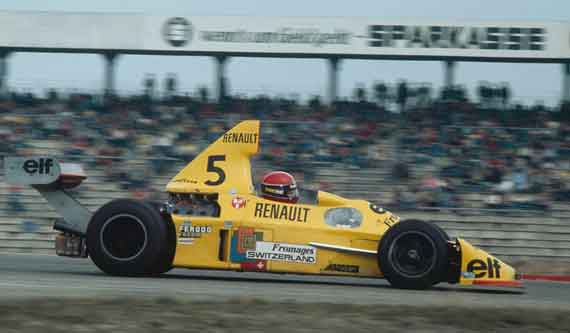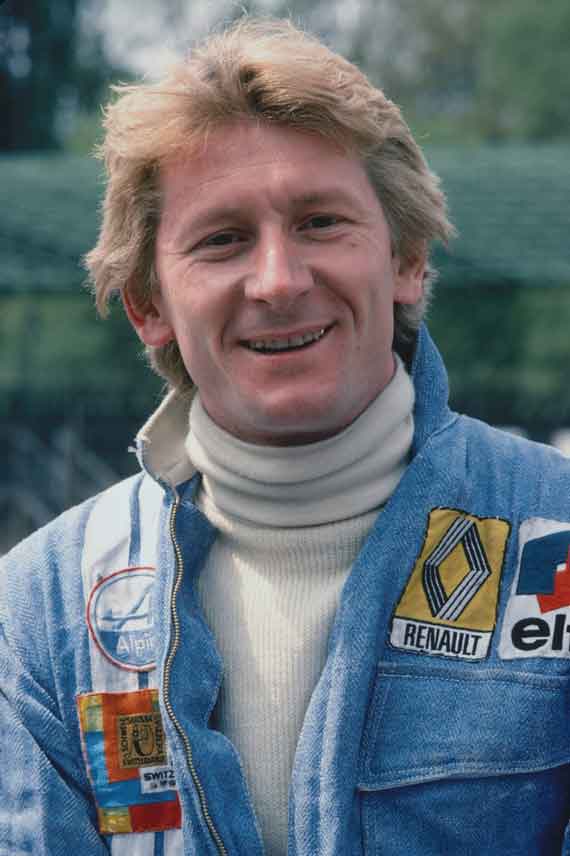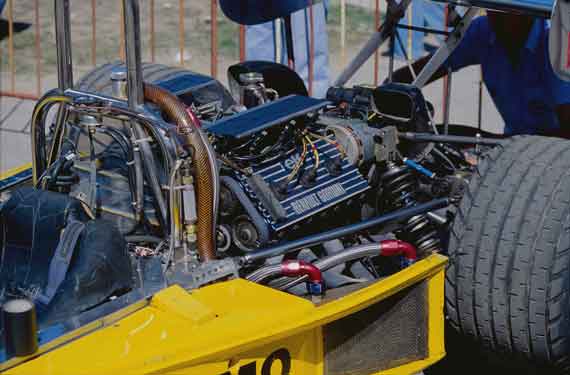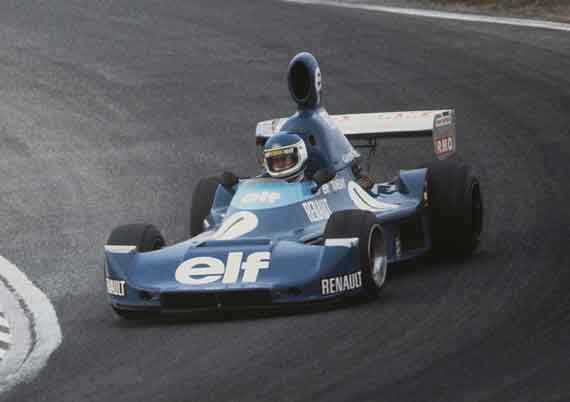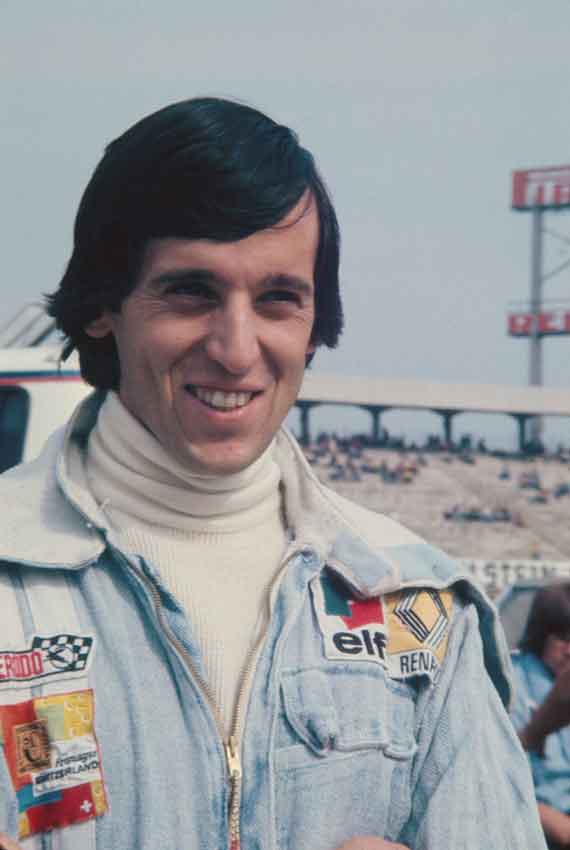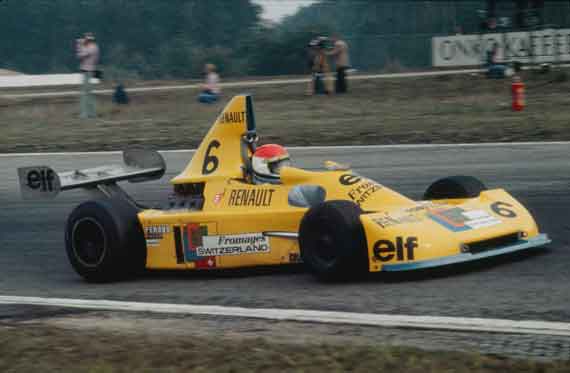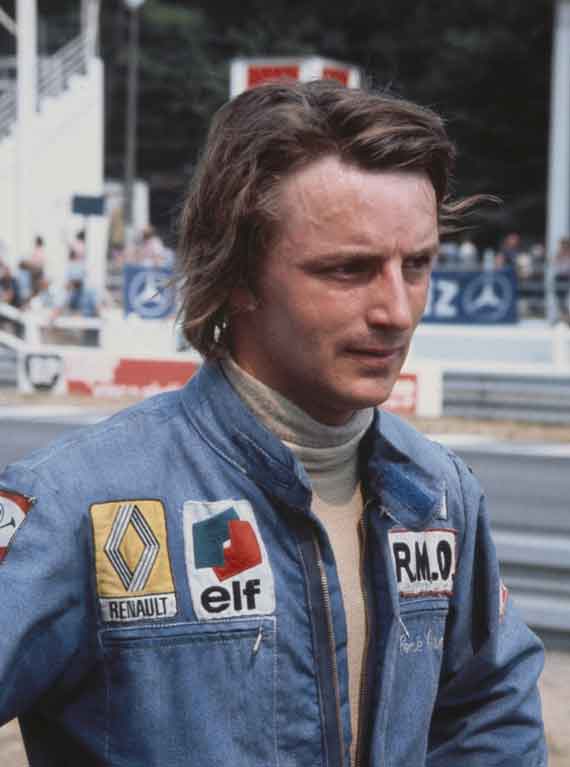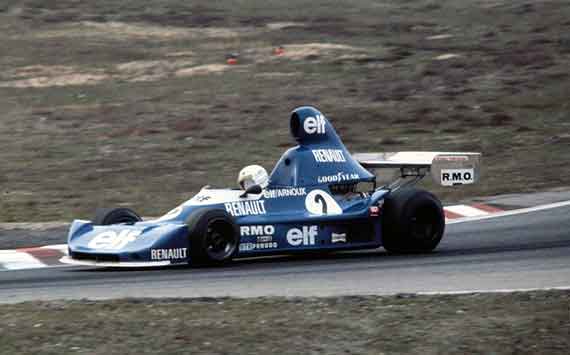By Roberto Motta
Renault Internal Press Photos
The 1976 European F2 championship was certainly one of the most exciting. The season was rich in emotions and duels on the track that led to the championship being awarded only after the last race. It was one of the most competitive years of those between 1967 and 1984, when the F2 championship was replaced by Formula 3000 due to the decrease of the participants in the F2 series.
The season ended with an incredible race that the press considered as the second most exciting race after the 24 Hours of Le Mans in ’69, when the Ford GT40-1075 Jacky Ickx and Jackie Oliver prevailed with a score of meters ahead of the Porsche 908 031 Hans Herrmann and Gérard Larrousse. The F2 championship included races that took place throughout Europe, attended by young drivers who sought to compete in F1, as well as many already established drivers.
The winter of 1975-76 saw many new innovations and improvements in race car technology. In that season one would encounter the 4-cylinder engines from BMW, Ford Cosworth, Hart and Roc Chrysler with 6 cylinders, including the V6 Renault Gordini CH1B, Lancia Stratos and the 6-cylinder in-line produced by Abarth and developed by Holbay. Among the competing chassis constructors were March, Chevron, Osella, Martini, Lola and some smaller manufacturers such as Toj and Boxer.
The most interesting feature of the season was the V6 Renault Gordini CH1B engine, which had enabled the Alpine A441 to win the European Sports Car 2 liter Championship. The Renault Sport engines would be available to Ecurie Martini, who had won the 1975 European F2 Championship with MK18 driven by Jacques Laffite. The Martini team consisted of Martini MK19s for Patrick Tambay and René Arnoux. Another team that received the engine was Elf-Alpine who provided the 2J Renault Elf for Michel Leclère and Jean-Pierre Jabouille. The season would witness a fierce battle between these teams. In the early tests, both of the Trans-alpine teams proved so fast and competitive as to be considered the favorites for the final victory.
The Championship
The season officially got underway on March 9 with the Jim Clark Trophy, a race that was held on the fast circuit of Hockenheim. The Elf-Renault started from the front row with the second fastest time obtained by Jabouille, behind the March-BMW of Hans Stuck.
The Elf-Renault immediately took command of the race but, but after only 4 laps, Jabouille’s V6 exhaust noise changed and became more and more rough in the operation. On the 8th lap the French car was overtaken by March-BMW of Stuck, who also won the second heat as the Elf-Renault eventually retired. As per the new regulations which gave the edge to newcomers, 9 points went to Arnoux in 2nd place, since Stuck was already an established professional who had raced regularly in F1 for two years. Arnoux preceded Patrick Tambay, both at the wheel of the Martini MK 19.
The next week the championship moved to Thruxton for Jochen Rindt Memorial. The race reserved a nice surprise to the Italian fans who saw Maurizio Flammini driving a March-BMW 762 to victory. For Flammini it was an unforgettable weekend: in addition to the victory, he won the pole position and the fastest lap in the race.
He tried to repeat his victory at Vallelunga, but while he was trying to catch up on Jabouille he was involved in an accident with an Osella, and jumped out of his car to assail the Osella driver. The marshals barely restrained the furious driver from Rome and the incident allowed to Jabouille and his J2 to win the nine points up for grabs.
Arnoux’s appointment with victory came in the prestigious Grand Prix at Paul Ricard, where he had the satisfaction of beating none other than the reigning champion Jacques Laffite.
The championship continued with the second of three events in Hockenheim, where Stuck again won both races. The 9 points for the championship were given to Leclère who came right behind him.
The seventh round of the championship was in Rouen, where, surprisingly, Flammini prevailed with a March-BMW ahead of Jabouille and Martini. At this point, Jabouille, Flammini and Tambay were tied, with Arnoux trailing by two points. Mugello saw Jabouille and Arnoux in first and second and Tambay third. In the next races, in Pergusa and Estoril,it was Arnoux who took the championship lead with 4 points ahead of Jabouille.
In the penultimate round of the season at Nogaro, the withdrawal of Jabouille in the 19th lap seemed to have handed over the title of European Champion for Arnoux. But fate was not of the same opinion, and the Martini driver broke his engine twenty laps later. The victory then went to his teammate Tambay, who finished ahead of Laffite and Leclère.
Before the final race at Hockenheim, René Arnoux with his Renault Martini MK 19 had 48 points, Jean-Pierre Jabouille driving the Elf-Renault 2J had 44 points and Patrick Tambay with Martini Renault MK 19 was up to 39 points.
The Challenge Hockenheim
On September 26, in Hockenheim, Arnoux saw himself as the favorite for the final victory. Mathematically, to win the title, he could settle for a 2nd place, even in the event that Jabouille won the race. Jabouille won the pole position with Renault Elf (chassis 03) ahead of Stuck with the March-BMW, followed by Tambay (Martini MK19 chassis 02), Arnoux (Martini MK19 chassis 03) and Leclère with the Elf Renault ( chassis 02).
On race day, the good weather of Saturday had given way to gray skies and rain on Sunday morning, though that ceased when the cars lined up for the race. The track remained dangerously slippery. At the start Jabouille immediately took the lead followed by Tambay and teammate Leclère.
At the end of the first heat, everything seemed to be proceeding as expected: Arnoux in the Martini had finished second, just behind of Jabouille and ahead of Leclère. But the fun had just begun. At the end of the first heat, Jean Sage, sports director of the Elf Renault/Jabouille and Leclère team, summoned the two drivers and set before them his strategy for the second half of the race. The plan was that Leclère would lap at a fast pace, while Jabouille would be confined to control Arnoux.
The race started, and everything went as planned. Leclère immediately imposed a fast pace, and accumulated a decent lead over Jabouille, who merely kept Arnoux in check.
Journalists and the public were very surprised because they did not understand what was happening. In fact, a Leclère victory ahead of Jabouille would hand the title to Arnoux! This was puzzling.
Then, a few laps from the end the second phase of the Sage strategy kicked in: Leclère was signaled to slow the pace. The French driver obeyed and led masterfully, winning the race with an advantage of only 7.9 seconds over Jabouille, an advantage that, due to the points system of the times, allowed to Jabouille to win the race and the title of Champion European with 1.5 seconds ahead of Leclère, who finished in second place.
After the lap of honor, the three riders went up on the podium for the awards while Arnoux received news that shocked him: he had lost the title in the last laps of the last race. In that moment in history was the image of a radiant Jabouille celebrating the victory, and a bitter Arnoux who could not comprehend what had happened.
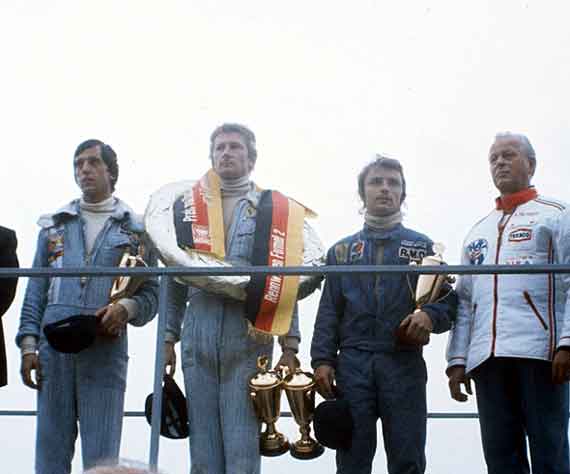
Final European Championship F2 Podium. From left, Michel Leclère, Jean-Pierre Jabouille and a bitter René Arnoux.
The final standings of the championship saw Jabouille with 53 points, Arnoux with 52 points, followed by Tambay and Leclère respectively with 39 and 33 points.
It was a win all French. The Elf2J and Martini MK19, all driven by the Renault V6 engine, had enabled the four young drivers from across the Alps to win the European summit.
Overall the Elf2J won 4 victories and 4 pole positions, took the podium six times and finished 12 races. It was a success that the French V6 confirmed the following season, when Arnoux was victorious with Martini MK21. In that last season the V6 Renault won 5 races, allowing its drivers to climb on the podium six times.
In Italia
L’INVASIONE RENAULT
di Roberto Motta
Foto di Renault Internal Press
La decima edizione del campionato europeo di F2 fu certamente una delle più esaltanti, perché ricca di emozioni e duelli in pista che portarono all’assegnazione del titolo solo all’ultima gara
Il campionato Europeo di F2 del ’76 fu uno dei più belli e combattuti tra tutti quelli disputati dal ’67 al ‘84, anno in cui il campionato fu sostituito dalla F 3000 a causa delle diminuzione dei partecipanti e al calo di interesse.
La stagione agonistica si concluse con una gara incredibile che la stampa di settore considerò come la seconda gara più avvincente dopo la 24 ore di Le Mans del ’69, quando la Ford GT40-1075 di Jacky Ickx e Jackie Oliver si impose con una ventina di metri di vantaggio sulla Porsche 908.031 di Hans Hermmann e Gérard Larrousse.
Il campionato F2 comprendeva gare che si svolgevano in tutta Europa, cui partecipavano giovani piloti che miravano a competere in F1 e piloti già affermati, normalmente impegnati nel campionato maggiore. Tuttavia, proprio per evitare che la classifica venisse dominata da piloti ‘professionisti’, il regolamento prevedeva che l’attribuzione del punteggio fosse riservato ai soli piloti emergenti.
Nell’inverno ’75-’76, con il concretizzarsi delle iscrizioni e con l’inizio dei test in previsione della nuova stagione agonistica, si incominciò a respirare una aria ricca di novità tecniche. Nella nuova stagione si sarebbero confrontati i motori a 4 cilindri BMW, Ford Cosworth BDX, Harth e Roc Chrysler con i 6 cilindri tra cui i V6 Renault Gordini CH1B, Lancia Stratos Dino e Armaroli e il 6 cilindri in linea prodotto dalla Abarth e sviluppato da Holbay.
Tra i telai in gara si sarebbero confrontati March, Chevron, Osella, Martini, Lola e alcuni costruttori minori come Motus, Toj, Boxer.
La novità più interessante del campionato era l’arrivo dei motori V6 Renault Gordini CH1B, che avevano consentito alla Alpine A441 di aggiudicarsi il Campionato Europeo Sport 2000. I Motori Renault sarebbero stati a disposizione del team campione in carica l’Ecurie Martini che si era aggiudicato l’europeo con la MK18 condotta da Jaques Lafitte e che avrebbe affidato le sue Martini MK19 a Patrick Tambay e Renè Arnoux; il team Elf-Alpine avrebbe affidato le sue 2J Renault Elf a Michel Leclère e all’esperto Jean Pierre Jabouille.
Fino dai primi test, Ii due team transalpini si dimostrarono tanto veloci e competitivi da essere considerati i favoriti per la vittoria finale.
Il Campionato
La stagione agonistica prese ufficialmente il via il 9 marzo ’76, con il Jim Clarck Trophy, gara che di svolse sul veloce tracciato di Hochenheim.
La Elf-Renault partì dalla prima fila grazie al secondo tempo ottenuto da Jabuille, alle spalle della March-BMW di Hand Stuck.
La Elf 2 prese subito il comando della gara ma, dopo soli 4 giri, il suo V6 cambiò rumore allo scarico e divenne sempre più ruvido nel funzionamento, tanto che all’8º giro la vettura francese venne superata dalla March-BMW di Stuck, per poi essere costretta all’abbandono per la rottura del propulsore.
Nella gara si impose Stuck il quale, come riportato dalla cronaca della gara scritta sul settimanale Autosprint, si aggiudicò nettamente entrambe le manche per la gioia dei quasi 200 mila spettatori assiepati lungo il velocissimo circuito tedesco.
Come da regolamento, i 9 punti andarono ad Arnoux, 2° classificato, poiché Stuck era già un professionista affermato che correva regolarmente in F1 da due anni.
Arnoux precedette Patrick Tambay, entrambi alla guida della Martini MK 19.
La settimana successiva il Campionato si trasferì a Thruxton per il Jochen Rindt Memorial. La gara riservò una bella sorpresa ai tifosi italiani che videro imporsi Maurizio Flammini alla guida di una March-BMW 762. Per Flammini fu un fine settimana indimenticabile: oltre alla vittoria, si aggiudicò la pole position e il giro più veloce in gara. Il pilota avrebbe potuto ripetere la sua impresa a Vallelunga, ma mentre stava cercando di recuperare lo svantaggio su Jabouille, il doppiato Binder alla guida di una Osella gli chiuse la traiettoria, coinvolgendolo in uno stupido incidente.
Flammini scese furioso dalla sua vettura per scagliarsi contro Binder. I commissari di percorso trattennero a stento l’indiavolato pilota romano. L’incidente consentì a Jabouille e alla sua J2 di concludere la gara al comando e di aggiudicarsi i 9 punti in palio.
Nella gara successiva, a Salisburgo, si impose ancora un pilota un francese, Leclère, che vinse la gara prevalendo su Flammini, Tambay e Arnoux.
Per il pilota di Grenoble Arnoux, l’appuntamento con la vittoria arrivò nel prestigioso Gran Premio del Paul Ricard dove si tolse la soddisfazione di battere niente meno che il campione in carica Jacques Laffite e di doppiare il secondo pilota classificato FIA Jarier, che si classificarono rispettivamente 2º e 4º con le Chevron di Fred Opert.
Il campionato proseguì con il secondo dei tre appuntamenti ad Hockenheim, dove si impose Stuck il quale, come nella gara di apertura del campionato, vinse entrambe le manche. I 9 punti per il campionato furono ad appannaggio di Leclère giunto alle sue spalle.
Per il settimo round il campionato fece tappa a Rouen dove, a sorpresa, si impose Flammini con la March-BMW davanti a Jabouille e Martini. Se fino a quel momento era stato equilibrato, ora vedeva al comando un trio di piloti a pari merito: Jabouille, Flammini e Tambay, con Arnoux staccato di due punti.
Al Mugello si impose Jabouille che precedette Arnoux e Tambay. Nella gare successiva, a Pergusa e all’Estoril, si impose Arnoux che prese la testa del campionato con 4 punti di vantaggio su Jabouille.
Nella penultima prova del campionato a Nogaro, il ritiro di Jabouille al 19º giro sembrava aver consegnato il titolo di Campione Europeo ad Arnoux, ma il destino non era dello stesso parere e il pilota della Martini ruppe il motore venti giri dopo.
La vittoria andò quindi al suo compagno di squadra Tambay che concluse davanti a Laffite e Leclère.
Per la gara conclusiva di Hockenheim la classifica vedeva in testa René Arnoux, con la sua Martini Renault MK 19 (48 punti), che precedeva Jean-Pierre Jabouille alla guida della Elf-Renault 2J (44 punti) e Patrick Tambay con la Martini Renault MK 19 (39 punti).
L’epica Sfida di Hockenheim
Il 26 settembre, a Hockenheim, Arnoux si presentava come il favorito per la vittoria finale. Matematicamente, per aggiudicarsi il titolo, il pilota di Grenoble avrebbe potuto accontentarsi di un 2° posto, anche nell’eventualità che Jabouille vincesse la gara.
Nel corso delle prove Jabuille conquistò la pole-position con la Elf Renault (telaio 03) precedendo Stuck con la March-BMW, seguivano Tambay (Martini MK19 telaio 02), Arnoux (Martini Mk19 telaio 03) e Leclère.con la Elf Renault (telaio 02)
Il giorno della gara, il bel tempo della giornata di sabato aveva lasciato il posto a un cielo grigio e alla pioggia della domenica mattina che cessò quando le vetture si schierarono per la gara, sebbene la pista rimase pericolosamente scivolosa.
Al via Jabuille prese subito il comando seguito da Tambay e dal compagno di squadra Leclère. Alla prima curva Stuck frenò all’ultimo e centrò rovinosamente la Elf Renault di Leclère.
Alla fine della prima manche, tutto sembrava procedere come da copione: Arnoux aveva concluso in seconda posizione, proprio alle spalle di Jabouille e davanti a Leclère. Ma stava per succedere qualcosa di imponderabile. Al termine della prima manche Jean Sagè, direttore sportivo di Jabouille e Leclère, convocò i due piloti ed espose loro la sua strategia per la seconda parte della gara. Il piano prevedeva che Leclère sarebbe scattato al via imponendo così un ritmo veloce, mentre Jabouille si sarebbe limitato a controllare a distanza Arnoux.
La gara partì e tutto si svolse come previsto. Leclère impose subito un ritmo di gara velocissimo, e accumulò un discreto vantaggio su Jabouille, che si limitò a controllare Arnoux.
I giornalisti e il pubblico rimasero alquanto stupiti perché non capivano cosa stesse succedendo. Infatti, una vittoria di Leclère davanti a Jabouille avrebbe consegnato il titolo ad Arnoux. Poi, a pochi giri dal termine scattò la seconda fase della strategia di Sagè: a Leclère venne segnalato di rallentare l’andatura. Il pilota francese obbedì e, guidato con maestria dai box, vinse la gara con un vantaggio di 7,9” su Jabuille, un vantaggio che, per la classifica con somma dei tempi, consentì a Jabuille di aggiudicarsi la gara e il titolo di Campione Europeo con 1,5” di vantaggio su Leclère che si classificò al secondo posto.
Dopo il giro d’onore, i tre piloti salirono sul podio per la premiazione e contemporaneamente Arnoux ricevette la notizia che lo sconvolse: aveva perso il titolo negli ultimi giri dell’ultima gara. Di quel momento rimase nella storia l’immagine di un raggiante Jabouille che festeggia la vittoria, e di un Arnoux amareggiato che non riesce a capacitarsi di ciò che era successo.
La classifica finale del campionato vide la vittoria di Jabuille con 53 punti, davanti a Arnoux con 52 punti, seguivano Tambay e Leclère rispettivamente con 39 e 33 punti.
Fu una vittoria tutta francese. Le Elf2J e le Martini MK19, tutte spinte dal propulsore Reanult V6, avevano consentito ai quattro giovani piloti d’oltralpe di conquistare la vetta Europea.
Complessivamente, in quel campionato, la Elf2J si aggiudicò 4 vittorie e 4 pole-position, salì sul podio 6 volte e concluse 12 gare. Un successo che il V6 francese confermò nella stagione successiva, quando permise a Arnoux di imporsi con la Martini MK21. In quell’ultima stagione il V6 Renault vinse 5 gare consentendo ai suoi piloti di salire 6 volte sul podio e partire 2 volte dalla pole position.
